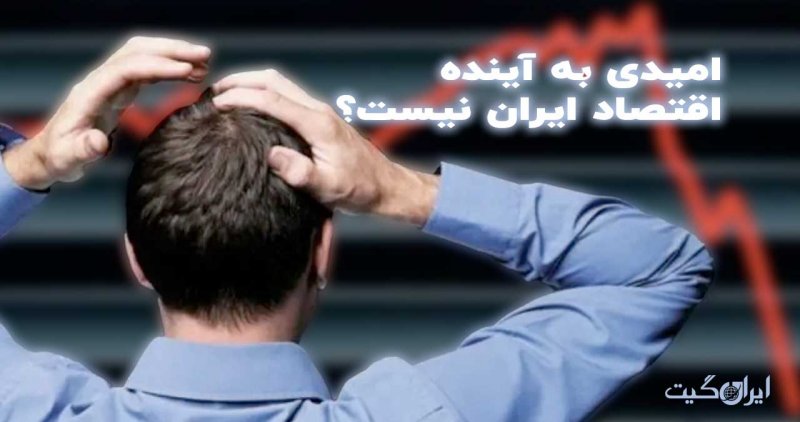No Hope for the Future of Iran’s Economy, Part One
We’ve often heard that even if Iran’s economy starts to reform and develop from today, there is still no hope for its future, and the idea of economic development should be abandoned. Some economists, in light of recent protests in the country, have made very concerning statements about the future of Iran’s economy, which have fueled this hopelessness. Given these circumstances, the question arises: Is there really no hope left for the country’s economy, and should we forever bid farewell to the development and improvement of economic conditions?
The machinery of Iran’s economy has a strange and complex nature that has simultaneously caused concern and astonishment among economic experts and analysts. It is such that an economist might never be able to accurately identify the various and often conflicting pillars of the country’s economy. However, to outline a vision for the economy, there is no choice but to understand this strange and unconventional structure.
In this context, Iran Gate has decided to prepare a three-part series to address the underlying issues of Iran’s economy and the hopes and fears that exist in the hearts of citizens. This report is the first part of this three-part series, which, given the ongoing protests in Iran, can provide a clearer perspective for the audience.
What is Economy?
In general, the economy is a complex field, and probably no economist will ever be able to fully master all the epistemological elements of this fascinating science. But what is the economy in general, and why should we strive to understand it?
At first glance, this mechanism is supposed to provide the basic needs for individuals and the community and ensure the livelihood of citizens. However, if we delve deeper, we will discover a profound nature through which people strive to reveal their potential abilities and desires. Thus, it is said that the economy is a kind of collective effort to create meaning and explore the individual and social dimensions of a person, weaving various stories in the process.
Moreover, in the mainstream economy, it is usually assumed that each person derives satisfaction solely from their own achievements, and the path to achieving that goal is not considered. However, on the other hand, behavioral research shows that there is a concept called transaction utility that contradicts this assumption, and this utility can even be more prominent than achieving the goal itself.
The State of Iran’s Economy is Not Good
All the propositions mentioned in this article were raised so that the audience avoids a purely numerical view of economic statistics and strives to gain a deep understanding of what needs to be done. Certainly, in the past ten years, Iran’s economic machinery has not been able to keep pace with the country’s population growth and the needs of citizens. However, the main problem might be that people cannot find a place for themselves in society. An Iranian youth currently faces a kind of crisis, unable to find their role in society.
If we view the economic crisis from this perspective, the main goal of reforms is not to increase the size of the economic pie, but rather the entire governance of the country should consider the dimensions of a human being and create a path where individuals can move towards flourishing. A significant part of a country’s people’s welfare stems from social and economic stability. When instability spreads in a country, individuals’ control over their surroundings and personal lives is severely weakened.
This decline in the level of control somehow damages individuals’ self-perceptions and injects a sense of helplessness into them. Consequently, a flow of self-blame emerges among citizens. Moreover, these instabilities destroy the social fabric and create a sense of loneliness, which signifies an economic crisis.
Attracting Foreign Investment is Key
Economic studies over a long period have shown that capital and labor have diminishing returns. The mentioned issue means that if an investment is to be made in a specific area, the first thousand dollars yield a hundred dollars, the second thousand yields seventy dollars, and the third thousand yields fifty dollars in a year, and so on, with subsequent thousands yielding diminishing returns.
This law also applies to the discussion of labor returns. If we apply this law to Iran’s economy, given that a vast level of the country’s potential remains untapped and investments are relatively low compared to other countries, opening the country’s doors to foreign investment and international cooperation in the early years can bring significant returns.
Of course, it should be noted that if a stable eight percent growth rate in the economy is achieved, although it is a very high figure, Iran’s economy will have a one hundred percent net growth over nine years.
Returning to the 1990s is Possible
Now, if we want to consolidate all the stated points, it should be said that if Iran embarks on the path of reforms, it might endure a cost for approximately five years to return to the early 1990s. However, embarking on the path of reforms and opening up opportunities, along with principled and meritocratic management, can initially bring significant returns for the people of Iran. On the other hand, creating stability in the country’s economy and removing negative expectations about the future will, in itself, lead to extensive reforms in the markets and smoother economic flow, which, in addition to economic growth, will bring more welfare to the people.
Ultimately, we must remember that after meeting basic human needs, people’s welfare and satisfaction come from the course of life, hope for the future, achieving their goals and dreams, and experiencing positive changes in their lives. Their income figures might not be a good indicator of citizens’ sense of happiness and prosperity.
- Where is the Destination of an Economy Without Public Trust? Part Three
- Iran’s Economy is Bankrupt, Part Two

